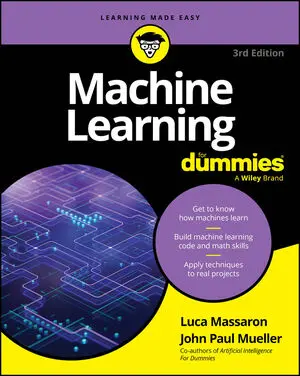This builtin is not currently supported: Animation
- Book & Article Categories

- Collections

- Custom Solutions
 Main Menu
Main MenuBook & Article Categories
 Main Menu
Main MenuBook & Article Categories
John Paul Mueller
John Paul Mueller is a freelance author and technical editor. He has writing in his blood, having produced 100 books and more than 600 articles to date. The topics range from networking to home security and from database management to heads-down programming. John has provided technical services to both Data Based Advisor and Coast Compute magazines.
Articles & Books From John Paul Mueller
The most human-friendly book on machine learning Somewhere buried in all the systems that drive artificial intelligence, you'll find machine learning—the process that allows technology to build knowledge based on data and patterns. Machine Learning For Dummies is an excellent starting point for anyone who wants deeper insight into how all this learning actually happens.
Cheat Sheet / Updated 06-09-2025
Although artificial intelligence (AI) has been around in some form since the 1950s, it was the first public release of ChatGPT and OpenAI’s foundational large language models (LLMs) like GPT 3.5 that made generative AI (GenAI) applications available to people who aren’t data scientists and computer geniuses.OpenAI’s models and models from companies such as Google, Facebook, Anthropic, and others ignited the world’s demand for increasingly sophisticated GenAI models and tools, and the market was quick to deliver.
A comprehensive roadmap to using AI in your career and in your life Artificial intelligence is everywhere. Major software organizations like Microsoft, Google, and Apple have built AI directly into products and invited the world to become part of the AI revolution. And it's impossible to use these tools to their fullest potential without understanding the basics of what AI is and what it can do.
The quick and crystal-clear guide to C++ programming C++ Essentials For Dummies is your useful reference to the key concepts of C++, the popular general-purpose language utilized everywhere from building games to writing parts of operating systems. With minimal review and background material—and absolutely no fluff—this book gets straight to the essential topics you need to know to ramp up, brush up, or level up.
Dive into the intelligence that powers artificial intelligence Artificial intelligence is swiftly moving from a sci-fi future to a modern reality. This edition of Artificial Intelligence For Dummies keeps pace with the lighting-fast expansion of AI tools that are overhauling every corner of reality. This book demystifies how artificial intelligence systems operate, giving you a look at the inner workings of AI and explaining the important role of data in creating intelligence.
Cheat Sheet / Updated 04-12-2024
A wide range of tools is available that are designed to help big businesses and small take advantage of the data science revolution. Among the most essential of these tools are Microsoft Power BI, Tableau, SQL, and the R and Python programming languages.Comparing Microsoft Power BI and ExcelMicrosoft markets Power BI as a way to connect and visualize data using a unified, scalable platform that offers self-service and enterprise business intelligence that can help you gain deep insights into data.
Install data analytics into your brain with this comprehensive introduction Data Analytics & Visualization All-in-One For Dummies collects the essential information on mining, organizing, and communicating data, all in one place. Clocking in at around 850 pages, this tome of a reference delivers eight books in one, so you can build a solid foundation of knowledge in data wrangling.
Cheat Sheet / Updated 10-03-2023
Python is an incredible programming language that you can use to perform data science tasks with a minimum of effort. The huge number of available libraries means that the low-level code you normally need to write is likely already available from some other source.All you need to focus on is getting the job done.
Article / Updated 09-13-2023
Many organizations are using Python these days to perform major tasks. You don't necessarily hear about them because organizations are usually reserved about giving out their trade secrets. However, Python is still there making a big difference in the way organizations work and toward keeping the bottom line from bottoming out.
Article / Updated 07-07-2023
You don’t need to understand absolutely every detail about how permanent storage works with Python in order to use it. For example, just how the drive spins (assuming that it spins at all) is unimportant. However, most platforms adhere to a basic set of principles when it comes to permanent storage. These principles have developed over a period of time, starting with mainframe systems in the earliest days of computing.








